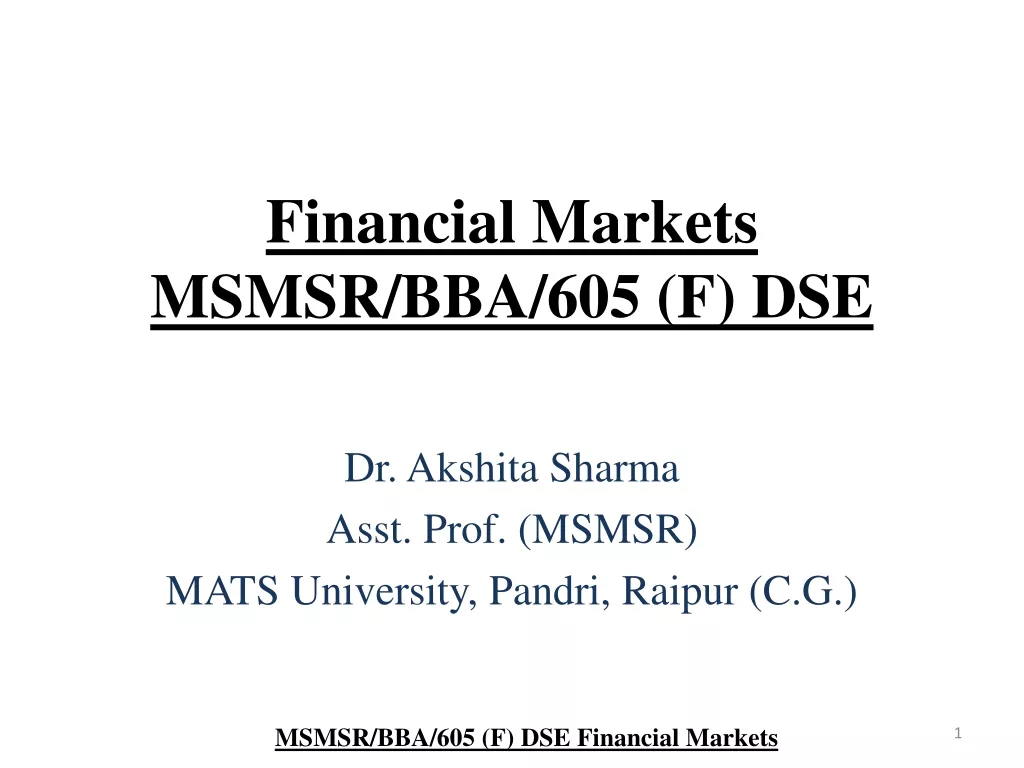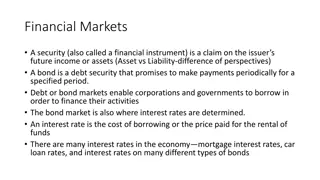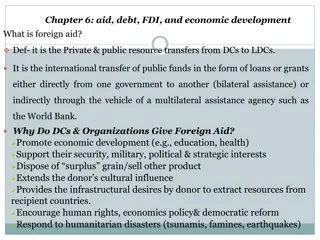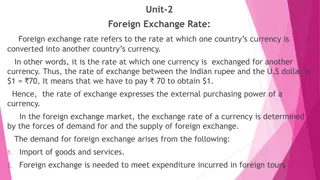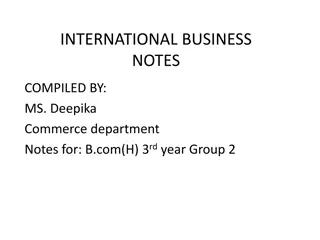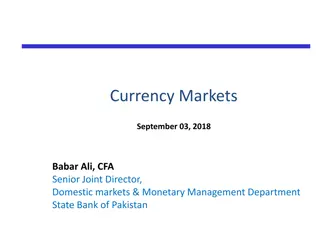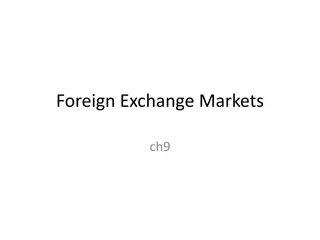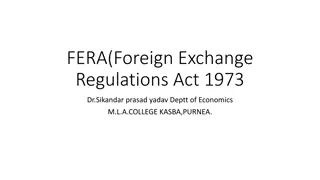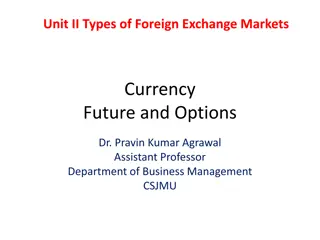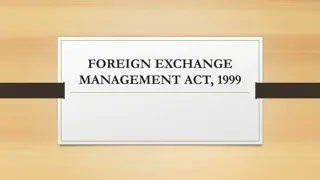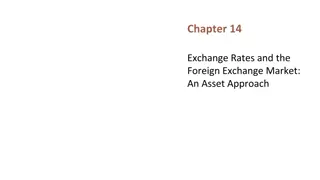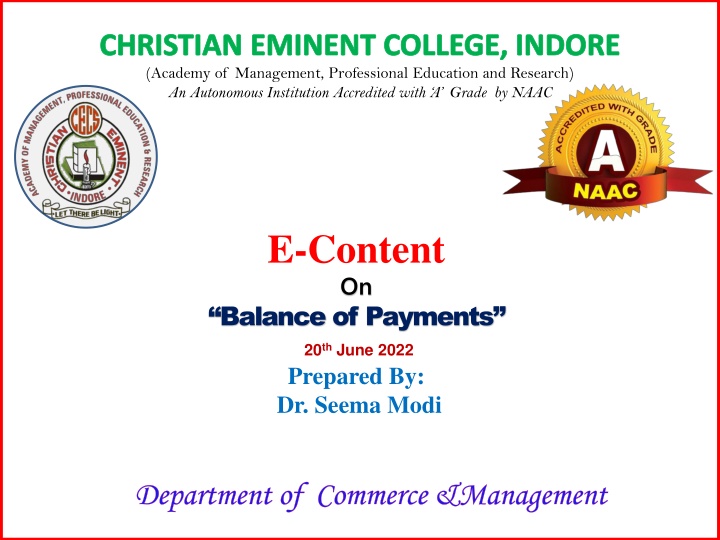
Foreign Exchange Markets
This content presents information on the basics of foreign exchange markets, including balance of payments, currency exchange rates, appreciation, depreciation, and determinants of exchange rates. It explains how markets and currency exchange are influenced by factors such as demand for products, interest rates, income changes, price fluctuations, and speculation.
Download Presentation

Please find below an Image/Link to download the presentation.
The content on the website is provided AS IS for your information and personal use only. It may not be sold, licensed, or shared on other websites without obtaining consent from the author. If you encounter any issues during the download, it is possible that the publisher has removed the file from their server.
You are allowed to download the files provided on this website for personal or commercial use, subject to the condition that they are used lawfully. All files are the property of their respective owners.
The content on the website is provided AS IS for your information and personal use only. It may not be sold, licensed, or shared on other websites without obtaining consent from the author.
E N D
Presentation Transcript
CHRISTIAN EMINENT COLLEGE, INDORE (Academy of Management, Professional Education and Research) An Autonomous Institution Accredited with A Grade by NAAC E-Content On Balance of Payments 20th June 2022 Prepared By: Dr. Seema Modi Department of Commerce &Management
Foreign Exchange Markets People exchange currencies because they want to buy foreign goods and services. The foreign exchange markets make currency exchange possible. Foreign Exchange Market- A market in which the money (currency) of one nation can be used to purchase (can be exchanged for) the money of another nation.
Foreign Exchange Foreign Currencies are known as foreign exchange. When the price of one country s currency is described in terms of another country s currency it is known as the exchange rate. One euro = 1.5 dollars One yen = 1/100 dollar One peso = 1/10 dollar
Flexible Exchange Rates Flexible or floating exchange rates are determined by supply & demand of one country s currency in terms of the value of another country s currency. In other words supply and demand determine the prices of currencies in the foreign exchange market
Appreciation & Depreciation of Currencies The values of currencies are described in terms of appreciation and depreciation. If one currency becomes more valuable in terms of another currency it appreciates. If one currency becomes less valuable in terms of another currency it depreciates.
Markets and Currency Exchange Demand for a currency is primarily determined by demand for a country s products. If there is an increase in demand for Samsung tablets, then there will be an increase in demand for South Korean currency (won). This increase in demand for the won would lead to an increase in supply of the dollar (we must supply our dollars in order to buy the won)
DETERMINANTS OF EXCHANGE RATES Changes in Tastes- a foreign good is popular (Toyota Prius) :. Demand for Yen up Relative Real Interest Rates If interest rates rise in US foreigners want to save here :. Demand for USD up Relative (Y) Income Changes- Europe goes into a recession :. Demand for USD down Relative Price Changes- Inflation hits China :. Demand for Chinese Renminbi down Speculation Currency traders expect the price of the USD to rise against the Euro :. Demand for the USD up
THE MARKET FOR CURRENCY The supply of pounds is upward sloping because US goods become cheaper as the dollar price of pounds rises so more pounds will be supplied to buy US goods P S Dollar price of one pound 3 The demand for pounds is downward sloping because as pounds become cheaper British goods become cheaper and Americans are willing to buy more British goods and more British pounds. 2 1 D Q Quantity of pounds
U.S. TRANSACTIONS Points to remember: U.S. exports create a foreign demand for dollars and a supply of foreign currencies in the Foreign Exchange Market U.S. imports create a domestic demand for foreign currencies and a supply of US dollars in the Foreign Exchange Market
Graphing Currency Exchange EXCHANGE RATE: $2 = 1 $3 = 1 P S Dollar price of one pound 3 Pound appreciates 2 D1 1 D Q Quantity of pounds
Graphing Currency Exchange EXCHANGE RATE: $2 = 1 S P S2 Dollar price of one pound 3 2 1 D D1 Q Quantity of pounds
Trading in the Foreign Exchange Market When an importer enters the foreign exchange market (FEX) he/she will be both a buyer and a seller of currency. As an importer you will be a buyer of the currency you need and a seller of the currency you have. Buyers = Demand Sellers = Supply
Graphing FEX-Instructions for Key Question #6 1) Restate the change described in the scenario 2) Tell if the Demand or the Supply of pesos has changed and how. 3) Show the change on FEX graph 4) Tell whether the peso has appreciated or depreciated
Exchange Rates & Trade Balances Flexible exchange rates automatically adjust to eliminate balance of payments deficits or surpluses. If there is increased demand for a country s goods (it has a trade surplus), then a country s currency increases in value, and its goods become more expensive. This decreases the amount that foreign citizens want, restoring trade balances.
BALANCE OF PAYMENTS This is a statement compiled by the U.S. Commerce Department that shows all the payments a nation receives from foreign countries and all the payments it makes to them. It is a statement of foreign exchange.
U.S. BALANCE OF PAYMENTS * (2007) Current Account 1)U.S. goods exports............................................................................... $+1149 2)U.S. goods imports............................................................................... -1968 3)Balance on goods......(lines 1 + 2)............................................................. - 819 4)U.S. services exports............................................................................ + 497 5)U.S. services imports............................................................................ - 378 6)Balance on services........(lines 4 +5)....................................................................... + 119 7)Balance on goods and services.......(lines 3 + 6)......................................................... - 700 8)Net investment income..(net interest & dividend payments on foreign financial assets)..... + 82 9)Net transfers (foreign aid, pensions for US retirees living abroad, money sent home by immigrants) - 113 10)Balance on current account ...(lines 7 + 8+ 9)........................................................ - 731 Capital Account 11)Foreign purchases of assets in the U.S..(foreigners buying US assets) ...........+ 2058 12)U.S. purchases of assets abroad...(US citizens buying foreign assets).............- 1289 13)Balance on capital account..........(lines 11 + 12)..................................................... + 768 14)Balance on current and capital account (10 + 13) ....................................................... + 37 Official Reserves account 14)Official reserves (the amount the Federal Reserve must inject or subtract to bring the balance to 0) - 37 BALANCE OF PAYMENTS $ 0 *in billion of US dollars
Balance of Payment Accounts Current Accountis a record of a country s currency exchange for the: exports and imports of goods and services net investment income interest income earned from foreigners on our foreign investments and paid out to foreigners for their investments here net transfers direct payments for foreign aid, pensions to U.S. citizens living abroad, a remittances by immigrants to relatives abroad and those same payments into the U.S.
Capital Account is a record of a country s currency exchange for the purchase or sale of real or financial assets and the corresponding monetary (capital) flows to pay for them. Real assets include office buildings, factories, homes, land. Financial assets include stocks and bonds (government and private). Decisions about investing are based on expected returns. This would be determined by interest rates on financial assets and expected profit on real assets.
Balance on the Current and Capital Accounts For both accounts exports (the sale of goods, services or assets) generate an accumulation of foreign currency and are considered a credit (+) and imports (the purchase of goods, services or assets) require the use of foreign currency and are considered a debit (-).
Official Reserves Account a measure of foreign currencies held in reserve by a country s central bank used to make up any deficit in the combined current and capital accounts. The bottom line must be zero. You must pay for your purchases with foreign currencies. Your inflows and outflows must balance. In our country our large current account deficits tend to be balanced with large capital account surpluses.
Appreciation & Depreciation of Currencies If an nation s currency appreciates, some foreign currency depreciates relative to it.

